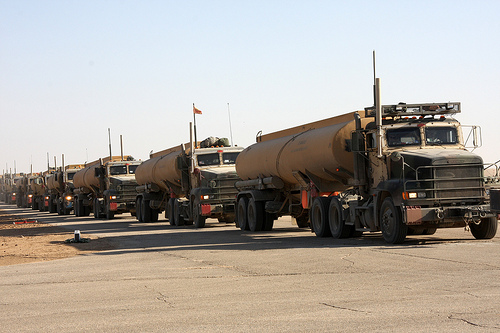
The U.S. Military’s latest strategy for the safety of our troops in Afghanistan is also a measure that is also sustainable. Renewable energy will now be utilized by the Marines so that they can be less dependent on fossil fuels while on the battlefield. Less dependence on fossil fuels has become an important issue because insurgents have targeted the American convoys repeatedly, resulting in many casualties. Solar energy in the form of portable panels, tent shades, and chargers for electrical equipment was recently taken into Afghanistan by a California Marine company so that their station can run without the need for fuel supply trucks to transport a lot of diesel and kerosene-based fuels.
Renewable energy will allow the military to focus more on the more important tasks in Afghanistan instead of putting so much effort toward protecting the fuel convoys. With renewable energy becoming more practical for military operations as they are now more reliable and cost-effective, it seems likely that it will be more common to see solar panels atop encampments. The Navy secretary, Ray Mabus said he wants 50 percent of the power to run the Navy and Marine bases, cars, and ships to derive from renewable energy sources by 2020. Since fossil fuels are most often a source of international conflict and many oil sources in unstable regions, Mr. Mabus and other military experts see renewable energy as not only a measure of troop safety, but national security.
The high risk of being attacked also increases the cost of transporting the fuels. The military purchases a gallon of gas for just over $1 and by the time it reaches some operating bases in Afghanistan, the cost skyrockets to $400. The Marine Corps commandant, General James Conway, described a fuel supply lines and convoys in Pakistan as, “costing us a heck of a lot and they’re very dangerous.” Fuel is the biggest import into Afghanistan by the military and it will always be an important asset, but more Marine companies will be selecting renewable energy in future months. The Marine camps in Afghanistan are the recipients of fossil fuel that was originally convoyed by 50 to 70 trucks to U.S. bases from shipping yards in Pakistan and often again convoyed by small fleets that are targets to enemy fire.
With solar energy abundant on the battlefield, the Marines of Company 1, Third Battalion, Fifth Marines, are the first to take initiative in sustaining their camp and communication systems with less fossil fuels. Moreover, the Navy and Air Force are investing in less fossil fuel dependent transportation. The U.S.S. Makin Island is the Navy’s first hybrid assault vessel, running on electricity at speeds under 10 knots. The Navy and Air Force are increasingly using biofuel from plants and algae sources in their fleets.
Image Credit: pewenenvironmentgroup via Flickr under a CC license.



Nice article Keenan!